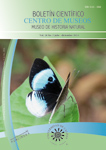Authors
Abstract
The purpose of this paper, is an inventory of the avifauna present in eight localities of the department of La Guajira, located in the transition zone of subtropical dry forest was performed. Line transect method was used to record each individual list and organizing families. 1103 birds in 27 families and 54 species censuses conducted between 6:00 am and 10 am one day in each month were recorded. The best was Columbidae family represented with five species, accounting for 9% of the same; followed in that order: Emberizidae and Tyrannidae, with 4 species each, Cuculidae, Icteridae, Parulidae, Psittacidae, Thamnophilidae and Trochilidae Alcenididae with 3 species and 2 species. The remaining families in general are represented by a single species, each contributing 2% of the total species detected throughout the study area; these represent 14% of all registered families. The town of High pine monitoring provided 26% of all individuals surveyed in the study, followed by Itaka, Ishipa, Caracarulella and Carraipía with 19%, 14%, 12% and 10% respectively.
Keywords
References
GENTRY, A.H., 1982. Neotropical Floristic diversity: phytogeographical connections between Central and South America, Pleistocene Climatic Fluctuations, or an accident of the Andean orogeny? Annals of the Missouri Botanical Garden, 69: 557-593.
HERNÁNDEZ-CAMACHO, J. & SÁNCHEZ-PÁEZ, H., 1992. Biomas terrestres de Colombia: 153-172 (en) HALFFTER, G. (comp.) La diversidad biológica de Iberoamérica I. Instituto de Ecología, A.C., México.
HILTY, S. & BROWN, W., 1986. A guide to the Birds of Colombia. Princeton University Press, New Jersey.
IDEAM, IGAC, IiAvH, INVEMAR, SINCHI, I. & IIAP., 2007. Ecosistemas continentales, costeros y marinos de Colombia. Instituto de Hidrología, Meteorología y Estudios Ambientales, Instituto Geográfico Agustín Codazzi, Instituto de Investigación de Recursos Biológicos Alexander von Humboldt, Instituto de Investigaciones Ambientales del Pacífico Jhon von Neumann, Instituto de Investigaciones Marinas y Costeras José Benito Vives de Andréis e Instituto Amazónico de Investigaciones Científicas Sinchi. Bogotá, D.C.
INSTITUTO ALEXANDER VON HUMBOLDT, IiAvH., 1998. El Bosque seco Tropical (Bs-T) en Colombia. Programa de Inventario de la Biodiversidad, Grupo de Exploraciones y Monitoreo Ambiental GEMA.
MARINKELLE, C.J., 1970. Birds of the serranía de Macuira, Guajira península Colombia. Mitt. Inst. Colombo-Alemán Invest. Cient., 4: 15-34.
McMULLAN, M., DONEGAN, T. & QUEVEDO, A., 2010. Field guide to the Birds of Colombia. ProAves Publications.
MILES, L., NEWTON, A.C., DE FRIES, R.S., RAVILIOUS, C., MAY, I., BLYTH, S. et al., 2006. A global overview of the conservation status of tropical dry forests. Journal of Biogeography, 33 (3): 491-505.
MORALES, A.NDREA, AYERBE, F., RODRÍGUEZ, D., RODRÍGUEZ-MAHECHA, J. & STREWE, R., 2007. Aves de la Guajira. Serie guías de bolsillo, Conservación Internacional.
MURPHY, P.G. & LUGO, A.E., 1986. Ecology of tropical dry forest. Annals Review of Ecology and Systematics, 17: 67-88.
SALAMAN, P., DONEGAN, T. & CARO, D., 2009. Listado de aves de Colombia 2009. Conservación Colombiana, 8: 1-89.
TELLERÍA, J.L., 1977. Introducción a los métodos de estudio de las comunidades nidificantes de aves. Ardeola, 21: 19-69.
TERBORGH, J., ROBINSON, S.K., PARKER, T.A., MUNN, C.A. & PIERPONT, N., 1990. Structure of an Amazonian forest bird community. Ecological Monographs, 60 (2): 213-238.

 PDF (Español)
PDF (Español)
 FLIP
FLIP


















